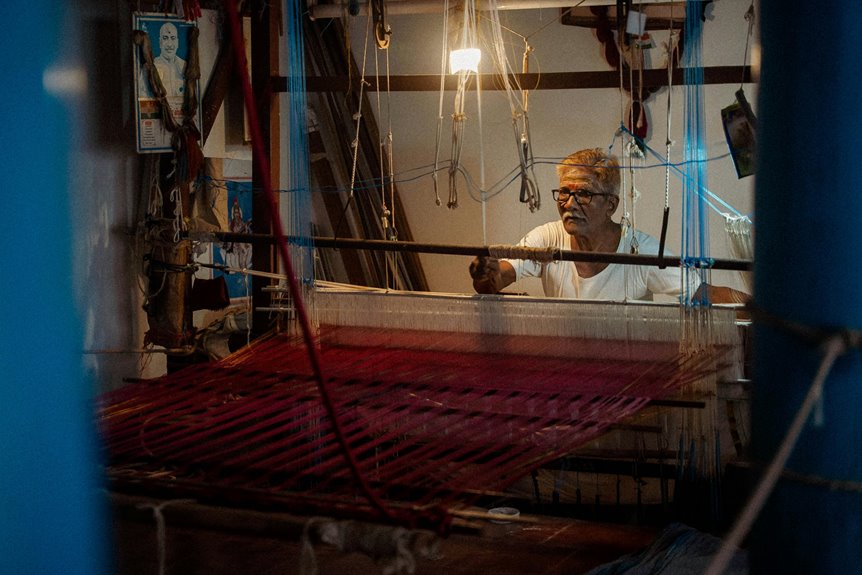Khadi is India’s hand-spun fabric that symbolizes self-reliance and freedom, famously promoted by Mahatma Gandhi. You’ll find it’s made by manually spinning cotton fibers on a charkha, then weaving them into cloth. Khadi supports rural artisans, promotes eco-friendly fashion, and connects you to India’s rich heritage. Whether cotton, silk, or wool, each type has unique charm. Keep exploring to discover its deep history, cultural value, and styling tips you’ll love.
Key Takeaways
- Khadi is a hand-spun, hand-woven fabric symbolizing India’s self-reliance and resistance to British colonial rule.
- It is traditionally made using the charkha, spinning cotton fibers into yarn and weaving them manually on a loom.
- Khadi supports rural artisans, promotes sustainable fashion, and boosts local economies by reducing dependence on mass-produced textiles.
- Varieties include cotton, silk, and wool khadi, each suited for different climates and occasions with unique textures.
- Proper care involves gentle washing in cold water, air drying in shade, and pairing with neutral tones to highlight its rustic charm.
The Historical Roots of Khadi and Its Role in Indian Independence
Although you might see khadi simply as a type of fabric today, it holds deep historical significance tied to India’s struggle for independence.
When you understand its roots, you’ll realize khadi was more than cloth—it became a powerful symbol of self-reliance and resistance against British colonial rule. Leaders like Mahatma Gandhi encouraged people like you to spin and wear khadi as an act of defiance, rejecting imported textiles that supported British economic control.
The Traditional Process of Making Khadi Fabric
Spinning khadi fabric starts with a simple tool called a charkha, which you can use to twist cotton fibers into yarn by hand.
First, you clean and card raw cotton to align the fibers. Then, you feed the cotton onto the charkha spindle, slowly turning the wheel to spin the fibers into a continuous thread.
After creating enough yarn, you move on to weaving. You set up a loom, often a handloom, and interlace the spun threads horizontally and vertically.
This manual weaving forms the khadi fabric’s distinctive texture and strength. Every step demands patience and skill, reflecting the fabric’s artisanal nature.
The Cultural and Economic Importance of Khadi in Modern India
Khadi embodies more than just fabric; it represents India’s spirit of self-reliance and cultural pride. When you wear Khadi, you support local artisans and empower rural communities, helping preserve traditional skills. Economically, Khadi boosts small-scale industries and reduces dependence on mass-produced textiles, fostering sustainable growth. Culturally, it connects you to India’s rich heritage and the freedom movement, symbolizing resilience and unity.
| Aspect | Impact on You |
|---|---|
| Self-Reliance | Encourages independence and pride |
| Artisan Support | Sustains livelihoods and craftsmanship |
| Eco-Friendly | Promotes sustainable fashion choices |
| Cultural Heritage | Connects you to India’s history |
Choosing Khadi means embracing values that uplift both people and the planet.
Different Types and Varieties of Khadi Fabric
Hand-spun fabric comes in various types, each offering unique textures and qualities that suit different needs and styles.
When you explore Khadi, you’ll find it’s not just one fabric but several varieties, each crafted with care.
- Cotton Khadi – Lightweight and breathable, perfect for hot climates and everyday wear.
- Silk Khadi – Luxurious and smooth, ideal when you want something elegant for special occasions.
- Wool Khadi – Warm and cozy, great for cooler weather and layering.
Each type carries the authentic charm of hand-spinning and weaving.
Styling Tips: How to Wear and Care for Khadi Clothing
Although natural fabrics require a bit more attention, you’ll find that caring for and styling Khadi clothing is straightforward and rewarding. To keep your Khadi garments looking fresh, wash them gently by hand or use a mild cycle in cold water. When styling, pair Khadi with simple accessories to highlight its rustic charm.
| Tips | Do’s | Don’ts |
|---|---|---|
| Washing | Use cold water, gentle soap | Avoid harsh detergents |
| Drying | Air dry in shade | Don’t expose to direct sunlight |
| Styling | Pair with neutral tones | Avoid heavy prints or textures |
With these simple practices, your Khadi clothes will stay vibrant and comfortable for years.
Frequently Asked Questions
Can Khadi Be Blended With Synthetic Fibers?
You can blend khadi with synthetic fibers, but doing so might affect its natural breathability and texture. If you want durability or stretch, blending helps, but pure khadi’s charm lies in its unblended, natural feel.
Is Khadi Fabric Suitable for All Seasons?
You’ll find khadi fabric suitable for all seasons because it’s breathable and lightweight, keeping you cool in summer and warm in winter. Its natural fibers adapt well, offering comfort no matter the weather conditions you face.
How Does Khadi Compare to Other Handwoven Fabrics Globally?
You’ll find khadi stands out with its breathability and eco-friendly nature compared to other handwoven fabrics worldwide. It’s lightweight, versatile, and carries unique cultural significance, making it both practical and meaningful in your wardrobe.
Are There Certifications to Verify Authentic Khadi Products?
You might spot fake khadi beside genuine hand-spun fabric, but don’t worry—you can verify authenticity through the Khadi and Village Industries Commission (KVIC) certification mark, ensuring you get true, traditional craftsmanship every time.
What Are Common Misconceptions About Khadi Fabric?
You might think khadi is outdated or coarse, but it’s actually soft and stylish. Some believe it’s machine-made when it’s hand-spun. Don’t assume it’s just cotton—it can include silk and wool too.

